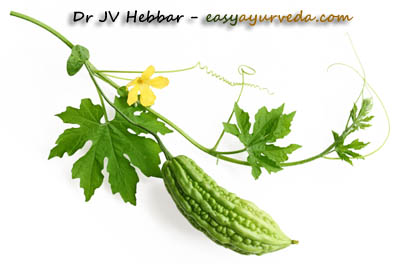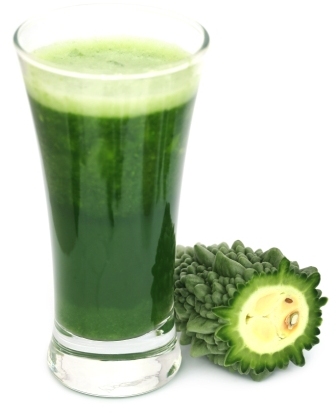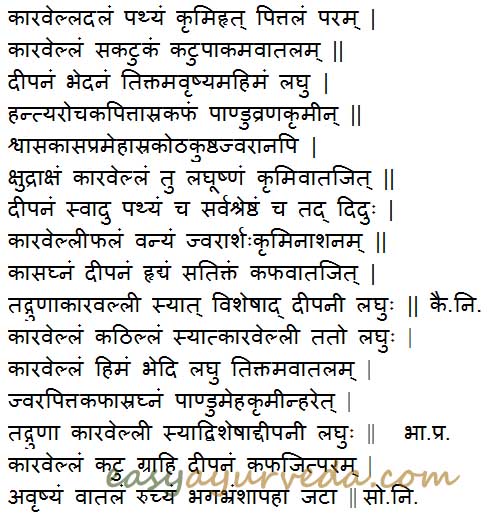Bitter Gourd (Karela): Benefits, Remedies, Research, Side Effects

Bitter gourd or Bitter melon, botanically, Momordica charantia is a well known Indian vegetable, useful for the treatment of diabetes, intestinal worms, sin disease, wounds and acts as blood purifier.
Latin Name- Momordica charantia Linn.
Family- Cucurbitaceae (kosataki kula)

Table of Contents
Vernacular names
Bitter melon: Names in different languages:
Hindi name- Karela
English name- Bitter gourd, Balsam pear, Bitter melon
Bengali Name- Karla, Uchhe
Gujarati Name- Kareli
Kannada Name- Hagalakai
Marathi Name- Karle
Malayalam Name- Kaippakka
Tamil Name- Pavaikkari
Telugu name- Kakar
Sanskrit synonyms
Sanskrit Synonyms of karela:
Kathillam – It imparts good effects on body Kandira, Kandakatuka, Sukanda, Ugrakanda, Katilla
Sushavi – Fruit yield many fruits
Karavellaka is a climber growing in the temperate region of India. It is cultivated for its vegetable use. The flowers are yellow in color and the fruit has triangular ridges on the outer side and grows up to 15-20 cm in length. The fruit is bitter in taste.

Classical categorization
Charaka samhita- Tikta skanda – bitter group of herbs
Sushruta samhita- Aragwadadi gana
Vagbhata- Aragwadadi gana
Bhavaprakasha- Shaka varga
Kaiyyadeva Nighantu- Oushadhi varga
Shodala Nighantu- Guduchyadi varga
Scientific classification
Kingdom: Plantae
Order: Cucurbitales
Family: Cucurbitaceae
Genus: Momordica
Species: M. charantia
Morphology
Annual herbaceous climber
Stem – Aerial, herbaceous
Leaves – Simple, alternate, multicostate reticulate venation
Inflorescence – Solitary
Flowers – yellow with 5 petals
Fruits -Berry
Seeds are immersed in red pulp
Properties, part used, dosage
Momordica charantia – Medicinal properties:
Rasa (Taste) – Tikta (Bitter), Katu (Pungent)
Guna (Qualities) – Laghu (Light), Ruksha (Dry)
Vipaka- Katu (Undergoes Pungent taste after digestion)
Veerya (Potency) – Ahima (neither a coolant, nor hot, as per Kaiyadeva Nighantu), Cold, as per Bhavaprakasha.
Karma (Action) – Kapha pitta hara (reduces vitiated kapha and pitta dosha), Deepana (induce appetite)
Part used- Leaf, Fruit
Dosage- Fresh juice 10-20 ml.
As per Bhojana Kutuhalam, karavella is penetrating in nature, hot in potency, alleviates doshas, promotes strength and acts as anti-toxicant. It treats praseka, dyspnoea, cough, hemorrhoids, worm infestation, skin diseases and fever.
Varieties
K. Ni 2 types
Briht karavella
Laghu karavella
Karela juice for obesity
Will drinking karela juice reduce obesity?
It reduces obesity, as it is de-nourishing in nature (1).
It also lowers blood sugar levels. Precaution is required for diabetics on medication.
It may cause excessive dryness of skin and internal organs.
Taking 15-20 ml of it 2 – 3 times a week, after food should be good.
Chemical constituents
Bitter gourd – Chemical constituents:
The fruit contains 5-hydroxytryptamine, charantin, diosgenin, lanosterol and beta sitosterol. It also contains bitter principles of cucurbitacin glycosides. The fruits and seeds yield polypeptide insulin called p- insulin, alpha and beta glycoproteins. The seed also contains hypoglycemic constituent vicine. Another protein called MRK-29 is found in the smaller variety of bitter gourd.
Uses, Sanskrit verse
Medicinal uses of Bitter melon:
- The juice of the fresh fruit of karavellaka is given in a dose of 20-25 ml to reduce the sugar level in blood.
- The paste of the leaf of Momordia charantia is applied over the area affected with skin diseases like eczema. The paste is also applied to treat wounds and external pile mass.
- The fresh juice of the fruit is given in a dose of 15-20 ml to treat intestinal worms, anorexia and liver disorders.
- The fruit is cut into small pieces and given to treat cases of fever.
- The juice of the fruit and leaves of karavellaka is given to treat conditions of amenorrhea and to purify the breast milk (as sthanya shodhana).
- The juice of the fruit is consumed daily in a dose of 20-25 ml to detox the blood and act like a blood purifier.
- The fruit is used as a vegetable and is found in many cuisines all over the world.

Ayurvedic uses of Karela:
karela leaves –
Pathya – can be taken as part of food
Pittala – Increases Pitta Dosha
Krumihara – useful in worm infestation, infected wounds
Bitter melon Fruit –
Deepana – improves digestion strength
Bhedana – causes mild laxative effect
Avrushya – Un-aphrodisiac
Indications
Arochaka – anorexia
Pittasra – Raktapitta –Bleeding disorders such as nasal bleeding, heavy periods, etc
Pandu – anemia
Vrana – Ulcers, wounds
Krumi – worm infestation
Shwasa – asthma and chronic respiratory disorders
Kasa – cough, cold
Prameha – Urinary tract disorders, diabetes
Asra – blood disorders such as abscess, skin disorders, bleeding disorders such as menorrhagia, nasal bleeding etc.
Kotha – allergic skin disorder
Kushta – skin diseases
Jwara – fever
How to consume bitter lemon?
Fruits are made into slices, put into a mixer to extract juice. Juice is readily consumed in 10 – 30 ml, by many diabetic patients. This is a very bitter remedy.
Boiled fruits are consumed.
It is used similar to any vegetable.
Adverse effects
Adverse effects of Bitter gourd:
Reported side effects include diarrhea, abdominal pain, fever, hypoglycemia, urinary incontinence, and chest pain. Symptoms were generally mild, did not require treatment, and resolved with rest.
Interaction with medicines, supplements
Can this be used while taking Homeopathic medicine?
Yes. This product does not react with homeopathic medicine.
Can this medicine be continued while taking supplements like multivitamin tablets, Omega 3 fatty acids etc?
Yes. Generally, this product goes well with most dietary supplements. However, if you are taking more than one product per day, please consult your doctor for an opinion.
With western
medicines
Seek your
doctor’s advice if you are taking this product along with other western
(allopathic / modern) medicines. Some Ayurvedic herbs can interact with modern
medicine.
If both Ayurvedic and allopathic medicines are advised together, then it is
best to take Allopathic medicine first, wait for 30 minutes and then take the
Ayurvedic medicine.
Ayurvedic medicines
Ayurvedic medicines containing Karela as ingredient:
Brihat Sarwa Jwarahara Lauh: This is an ayurvedic medicine in tablet form and is given to treat all types of fever. This formulation contains metals in its powder form.
Aragwadadi kashaya: This is an ayurvedic medicine in decoction form used for the treatment of various skin diseases, wounds and kaphaja jwara.
Diabac tablet: It is a proprietary ayurvedic medicine used to treat diabetes and complications arising out of the disease.
Glukostat capsule: Glukostat Capsule is a pancreatic stimulant and insulin sensitizer and is used in diabetic conditions.
Diabegon capsule: Diabegon Capsule is a proprietary Ayurvedic medicine, manufactured by Dindayal Industries Ltd, Gwalior. It is used in the treatment of diabetes.
Choles capsule: It is a proprietary ayurvedic medicine used to treat hyperlipidemia.
Nidd forte tablets: It is a proprietary ayurvedic medicine used to treat non- insulin dependent diabetes.
Limit capsules: It is a proprietary ayurvedic medicine used to treat non- insulin dependent diabetes.
Research articles
Research articles on Karavellaka:
Anti- diabetic effect: It has been estimated that up to one-third of patients with diabetes mellitus use some form of complementary and alternative medicine. Abundant pre-clinical studies have documented in the anti-diabetic and hypoglycemic effects of M. charantia through various postulated mechanisms. However, clinical trial data with human subjects are limited and flawed by poor study design and low statistical power. The present review is an attempt to highlight the anti- diabetic activity as well as phytochemical and pharmacological reports on M. charantia.
Anti- malarial benefit: This experiment investigated the effects of M.charantia L. and M.jalapa L. on malaria in a 4-day suppressive test. Animals received 50, 100, or 200 mg/kg of methanolic extracts orally. M.charantia and M. jalapa methanolic extracts had intrinsic antimalarial properties that were dose-dependent. The result showed that M.charantia was effective in suppressing malaria at the highest dose tested (200 mg/kg) while M. jalapa gave the highest chemo suppression of parasitemia at the lowest tested dose of 50 mg/kg body weight of mice.
To control obesity: Momordica charantia (bitter melon, BM) is a traditional Chinese food and well known for its function of reducing body weight gain and insulin resistance. In this study, C57BL/6 mice were fed a high fat diet (HFD) with or without BM for 12 weeks. BM-contained diets ameliorated HFD-induced obesity and insulin resistance. Histological and real-time PCR analysis demonstrated BM not only reduced macrophage infiltration into epididymal adipose tissues (EAT) and brown adipose tissues (BAT). Flow cytometry shows that BM could modify the M1/M2 phenotype ratio of macrophages in EAT.
Hepato-protective action: The aim of this study was to investigate the anti- hyperglycemic activity of Momordica charantia fruit on alloxan induced diabetic mice and its antitoxic effect on liver. Mice were alloxanized (alloxan monohydrate 150 mg/kg body weight administered intraperitoneally) and aqueous extract of Momordica charantia at the rate of 100 mg/kg body weight was administered for 21 days to evaluate its anti- hyperglycemic activity. There serum glucose levels as well as the Liver Function Tests (LFT) – SGPT, SGOT and total bilirubin levels were analyzed statistically using ANOVA and Dunnett’s tests
Balsam-pear (bitter gourd), leafy tips, raw
Taste – Bitter, Pungent
Properties – light, dry
Potency – Hot
After digestion taste transformation ( Vipaka ) – Pungent
Effect on Doshas
Vata increasing
Pitta balancing
Kapha balancing
Balsam-pear (bitter gourd), leafy tips, cooked, boiled, drained, without salt
Taste – Bitter, Pungent
Properties – light, dry (becomes more light o boiling)
Potency – Hot
After digestion taste transformation ( Vipaka ) – Pungent
Effect on Doshas
Vata increasing (more Vata increasing than raw bitter gourd)
Pitta balancing
Kapha balancing (more Kapha balancing than raw bitter gourd due to increased lightness)
Balsam-pear (bitter gourd), pods, raw
Taste – Bitter, Pungent
Properties – light, dry
Potency – Hot
After digestion taste transformation ( Vipaka ) – Pungent
Effect on Doshas
Vata increasing
Pitta balancing
Kapha balancing
Balsam-pear, pods, cooked, boiled, drained, without salt
Taste – Bitter, Pungent
Properties – light, dry (becomes more light on boiling)
Potency – Hot
After digestion taste transformation ( Vipaka ) – Pungent
Effect on Doshas
Vata increasing (more Vata increasing than raw bitter gourd)
Pitta balancing
Kapha balancing (more Kapha balancing)
Balsam-pear (bitter gourd), leafy tips, cooked, boiled, drained, with salt
Rasa – Bitter, Pungent, slightly salty
Guna – light, dry (becomes more light o boiling)
Veerya – Hot
Vipaka – Pungent
Effect on Doshas
Vata increasing (more Vata increasing than raw bitter gourd)
Pitta nourishing (as salt is hot in potency and increases Pitta)
Kapha balancing (more Kapha balancing than raw bitter gourd due to increased lightness)
Balsam-pear, pods, cooked, boiled, drained, with salt
Rasa – Bitter, Pungent, slightly salty
Guna – light, dry (becomes more light on boiling)
Veerya – Hot
Vipaka – Pungent
Effect on Doshas
Vata increasing (more Vata increasing than raw bitter gourd)
Pitta nourishing (as salt is hot in potency and increases Pitta)
Kapha balancing (more Kapha balancing)
Author:
Dr.B.K.Prashanth M.D (Ayu), Ph.D
E mail: [email protected]
Sthanika Karma (Systemic Action)
External Application – Wound cleaning and healing action. indicated in skin disorders. Leaf decoction helps to cures burning sensation
Internal administration-
Digestive System – Carminative, digestant, purgative, Ant helminthic, liver stimulant. Indicated in Anorexia, loss of appetite, liver disorders, constipation, Hemorrhoids, Helminthiasis etc.
Circulatory System – Indicated in edema, acts as a blood purifier.
Respiratory system – Pacifies kapha dosha, indicated in cough.
Excretory System – Indicated in Diabetes (Madhumeha). Increases insulin activity, improves the functioning of the liver and Stomach thereby helps for the elimination of metabolic waste.Reproductive system – Uterine stimulant. Purifies the breast milk, indicated in oligomenorrhea, amenorrhea etc.
Satmikarana –Indicated in Obesity. Anti poisonous.
Tapakrama – stem is indicated in fever
Tvak – Indicated in Udarda (Type of skin condition)











3 comments
Mahesh rada
Great posts. I have read many posts of doctor Webber for example ashwagandha. People should use ayurveda with knowledge. Otherwise it also has side effects.so dosage and duration is always important while using ayurveda herbs.
Apurv Gupta
Karela is Cold in nature your website is showing is Hot. I have used and feel the coolness.
Anel Xer
Thank you!!!